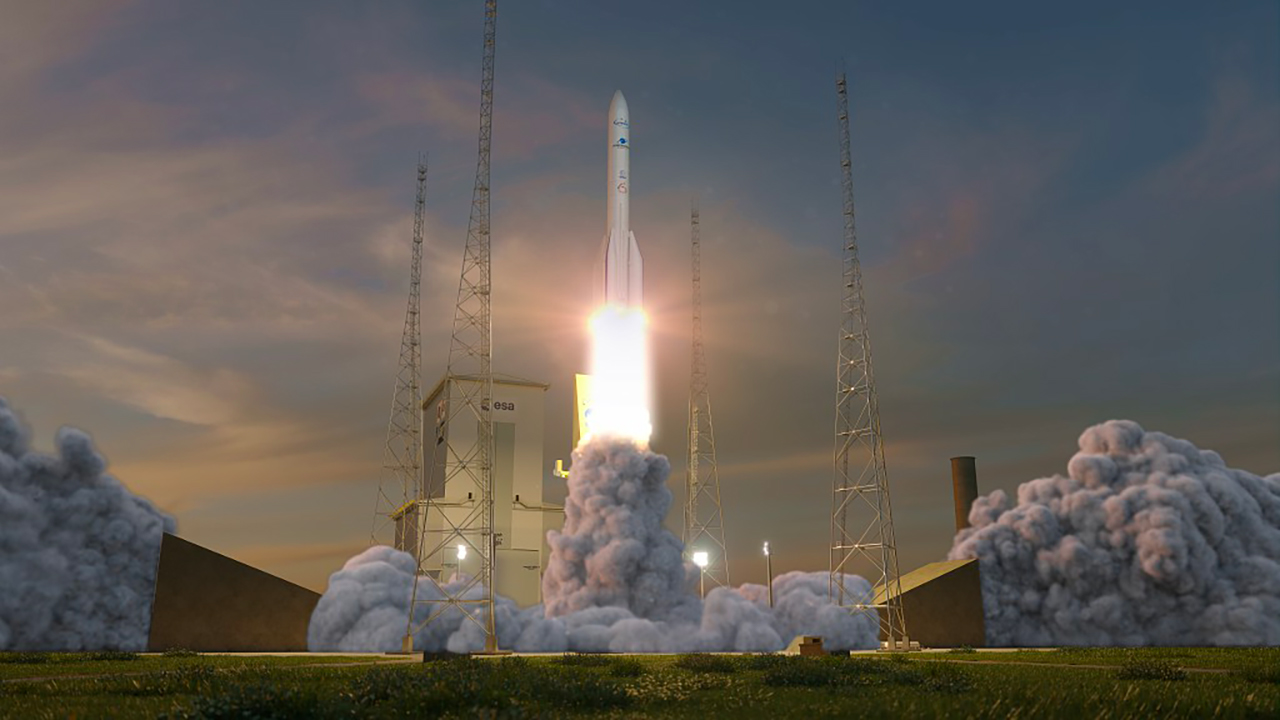Ariane 6: a launcher designed to evolve
26.09.2022

The Ariane 6 launcher was designed to be ultra-flexible: it can perform a very large number of different missions, to all orbits. It was also designed to be able to continuously adapt by incorporating new technologies, thanks to its modularity. New stages, new boosters, new engines: let’s take a look at the possibilities.
From the outset, the engineers at ArianeGroup designed Ariane 6 to offer the greatest possible flexibility to Arianespace’s customers, whether institutional or commercial. The new European launcher can perform a very large number of different missions, to all orbits: low, medium, geostationary, sun-synchronous, polar, to the Lagrange points, the Moon or deep space. It is highly flexible thanks to its two-booster Ariane 62 and four-booster Ariane 64 versions, but also thanks to its very large capacity fairing and its multiple launch system, its payload adapters and the many types of dispensers it can accommodate. It is particularly well-suited to constellation launches, with its reignitable Vinci engined upper stage, in association with its APU (Auxiliary Power Unit) offering high flexibility and optimization of injections to multiple orbits.
In addition to these initial qualities, Ariane 6 is also designed from the drawing board for upgrading through the incorporation of new technologies, thanks to its modularity. This is an integral part of its design, so that its key elements can adapt to always remain at the cutting edge: new equipment, new engines, new stages or new boosters. Ariane 6 will thus be able to optimize its performance and competitiveness over the long term, while further boosting its flexibility. It will thus be able to accomplish new types of missions, meeting the changing needs of the market.
The first upgrades are already on the way
The first Ariane 6 upgrades are already in development. The Astris “kick stage” is an additional stage for optimizing the launcher’s versatility, enabling it to carry out new and atypical missions, such as taking electric satellites directly to their final orbit destination, launching multi-orbit constellations and performing extra-planetary missions to the Moon or to asteroids. In July 2021, the European Space Agency (ESA) awarded an Astris development contract to ArianeGroup.
On Ariane 64, the MLS (Multi-Launch System) will offer “ride-share” capability for the launch of groups of small and micro-satellites.
Replacement of the existing Ariane 6 upper stage by an ultralight stage called Icarus (Innovative Carbon ARiane Upper Stage), making extensive use of carbon composite materials technologies, will enable the launcher’s performance to geostationary transfer orbit (GTO) to be increased by almost two tons. The research and technology development work is already under way, for example to study carbon composite liquid hydrogen tanks. This is covered by the Phoebus contract awarded to ArianeGroup by ESA in May 2021.
P120C+, a boosted booster
Another major development will be the P120+ solid rocket motor, one meter longer than the existing P120C, and in which the load will be increased to 156 tons, up by 10%. The new booster will further improve the capabilities and competitiveness of Ariane 6: the longer propulsion time will increase the launcher’s performance by more than two tons to low Earth orbit, for the launch and early orbit phase of mega-constellations, and will offer significant performance gains for geostationary, scientific, and exploration missions. ESA intends to include the development of the P120C+ in the program proposals presented at its Ministerial Council meeting in November 2022.
A new high-power, low-cost engine: Prometheus®
The in-development Prometheus® engine for the future generations of launchers could also be trialed on Ariane 6. The contract for a new development phase of a series of Prometheus® demonstrators, awarded to ArianeGroup by ESA in May 2021, also provides for the development of a version of the engine running on liquid hydrogen (instead of methane). This version with 120 tons of thrust could replace the core stage Vulcain 2.1 engine. Two Prometheus® engines would provide 240 tons of thrust, enabling Ariane 62 to increase its geostationary launch capability and perform additional missions, with reduced costs.
Ariane 6 – already reusable?
On a later version of Ariane 6, the solid rocket boosters could be replaced by Liquid Reusable Boosters (LRB). With dimensions identical to those of the Themis reusable stage demonstrator – for which the development lead was entrusted to ArianeGroup by ESA in 2020 – a booster such as this using three Prometheus® engines running on liquid oxygen and methane would offer a “plug-and-play” alternative for the P120C+, helping to bring down operating costs with high launch rates. This would also contribute to preparing the next generation of launchers by already incorporating reuse technologies into Ariane 6.
Finally, Ariane 64 could be equipped with the Susie “smart” upper stage proposed by ArianeGroup. This stage, which could also fly on future generations of launchers, would be able to carry out automated freighter missions and crewed missions to space, with a crew of up to five astronauts, and then return for a safe landing on Earth.
‘@ArianeGroup